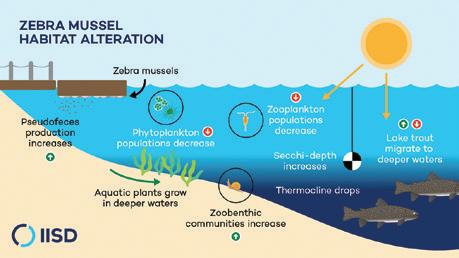
3 minute read
LOWDSA launches attack on zebra mussels and other invasive species
Brie McCardle of the LakeSmart team washing a boat. This year LOWDSA partnered with OFAH and borrowed their mobile boat wash station.
BY CASSIDY MAZUR, ENVIRONMENT PROGRAM COORDINATOR, LOWDSA
Advertisement
You’ve probably heard of zebra mussels by now—the horror stories from Lake Winnipeg’s beaches now sharp with shells, coating water intake pipes in the Great Lakes, and ruining boat motors and docks. The Minnesota Department of Natural Resources (MN DNR) detected veliger’s (larval stage) in the Southern basin of Lake of the Woods in their 2019 and 2020 samples. Just this year, Lake Manitoba Narrows and Rainy Lake had veliger’s confirmed in most samples, indicating a reproducing population of zebra mussels in the waterbodies. Rainy Lake straddles the Ontario-Minnesota border and flows downstream through the Rainy River to Lake of the Woods. Adult populations have not been located in Lake of the Woods to date.
The presence of zebra mussels impact the physical, chemical, and biotic aspects of their environment, earning the organism the classification of an ecosystem engineer. However, the changes that aren’t quite so visible initially are equally alarming. Their cascading effects through ecosystems are shown in this infographic from IISD-ELA and can cost lake users and governments billions of dollars once a population is established.
Invasive species such as zebra mussels alter the populations of native organisms and change various ecosystem components by outcompeting native organisms in our water. Zebra mussels can reach densities of 700,000 per m², and as each mussel filters one litre of water per day they consume food and nutrients which reduces the availability of food for our native zooplankton, which are the base of the food web. They also remove particles like algae which increases water clarity and allows sunlight to penetrate deeper into the increasingly clear water, consequently increasing aquatic plant growth and warming water temperatures, pushing cold-water fish deeper into low oxygen water. The presence of zebra mussels can also increase harmful algal blooms.
Preventing the spread of aquatic invasive species is more important now than ever and early detection of an invasive species increases the likelihood of containment from further spread, making management more successful and cost-effective. This summer LOWDSA’s introduced its new zebra mussel monitoring program and distributed 29 settlement samplers to members and the public to monitor for zebra mussel presence in the watershed. Grand Council Treaty #3 distributed 32 samplers to Treaty #3 communities, totalling at least 61 in the Lake of the Woods watershed. To support early detection and to be a part of our program, please email info.lakesmart@lowdsa.com.
LOWDSA supports the prevention of spreading invasive species like zebra mussels through our Mobile Boat Wash Station that serves as a self-contained education program complementing our LakeSmart program. In the previous issue of the Area News, we mentioned that the Boat Wash Station focuses directly on invasive species and provides decontamination opportunities for lake users to significantly reduce the chance of introducing invasive species to water bodies through the use of pressure washers.
This summer, we partnered with the Invading Species Awareness Program to borrow their boat wash and operate it for the season. In just 10 days of operation, the LakeSmart team decontaminated 35 boats sharing information on the practice of “Clean, Drain, Dry” to lake users coming in and out of boat launches this summer. The team spoke to 143 people about the risks of invasive species, how to identify them, and report sightings. This is in addition to distributing 76 dock kits containing resources on invasive species and other water quality topics.
To support programs such as the LOWDSA Mobile Boat Wash Station, you can donate to our Environmental Initiatives and Special Projects Fund. Your contributions allow us to continue providing and growing these programs and services that protect water quality and take action against invasive species in the Lake of the Woods district.

What you can do to reduce the spread of invasives like zebra mussels
• CLEAN any mud, vegetation, mussels, or anything suspicious from your boat and gear before leaving the water.
• DRAIN all standing water from motor, live well, bilge and transom wells at the boat launch.
• DRY your boat for five or more days in sunlight to remove invaders you can’t see, OR clean with a high pressure wash or hot water.
• Report sightings of invasive species to EDDMapS by visiting their website or downloading their app, or contact the Invading Species Hotline at 1-800-563-7711
• Submerse hard-to-clean fishing equipment and nets in hot water (40°C) for ten minutes.
More information:
dnr.state.mn.us/news/2021/09/01/zebra-mussel-larvae-confirmed-rainy-lake-st-louis-county
lowwsf.com/index.php?option=com_content&view=article&id=2 40:zebra-mussel-larvae-confirmed-in-rainy-lake&catid=9
greatlakesnow.org/2021/02/invasive-mussels-legacy-beyond-great-lakes/
greatlakesnow.org/2020/02/zebra-mussels-impact-good-bad/
iisd.org/ela/blog/commentary/this-is-what-zebra-mussels-do-to-a-lake/










